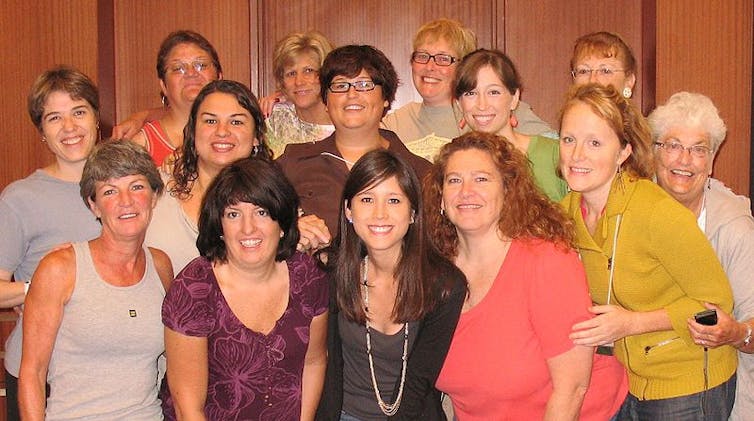All societies divide people into male or female. There is a biological truth behind this: different sex chromosomes (XY,XX). But could many gender differences be down to social conditioning? If we treated girls and boys the same from birth, what would the consequences be? More equal opportunities? Or a complete breakdown of the concepts of masculinity and femininity? These ideas partly depend on what we understand by “gender identity”.
Gender identity is not a simple concept. It is usually defined as whether someone thinks of themselves as male or female, though it’s more than that. Even this is not a simple, binary division between all human beings. However, we do know that the hormones the brain is exposed to in early pregnancy have powerful effects on gender identity.
For example, there’s a condition called androgen insensitivity syndrome. Girls with this condition are born looking just like other girls. Only at puberty do things start to change. This is because they are actually genetic males (they have the male XY chromosomes). They also have testes, hidden in their abdomen, but no uterus or ovaries.
The condition is caused by a genetic insensitivity to the hormone testosterone, so that while these girls secrete male-type levels of testosterone, it doesn’t have any effect on their brain (or anywhere else). The important point is that their gender identity is female. Does that mean that testosterone is ultimately what makes someone masculine? The experimental evidence suggests as much. Giving little female rats testosterone during early life makes them very male-like, and the opposite occurs if little males are castrated.
Testosterone seems to be important, but is it the whole story? Is the fact that individuals with androgen insensitivity syndrome look like women responsible for others treating them as female, thus influencing how they see themselves?

In the 1960s, John Money, a prominent psychologist, convinced himself that gender identity was independent of early hormones. Put simply, if a parent thought their baby was a boy, and treated him as such, then he developed a male gender identity, and vice versa. This idea was put to the test: after a surgical accident, a one-year old boy was castrated and given a vagina. He was dressed as a girl and given a female name. But it failed. Eventually, the “girl” reverted to being a boy. You might think that was the end of the “parent” theory of gender identity. But a second case, which started when the baby was two months, succeeded. The “boy” grew up as a “girl” and accepted her gender identity, though she was bisexual.
So why the different results? Note that single case reports are unreliable as evidence. But it seems likely that exposure of the brain to testosterone during development does influence various aspects of sexuality, including gender identity. We also know that the brain in early life is very susceptible to external events. So both testosterone and parental behaviour can influence gender identity.
Beyond hormones
But gender identity is also how a person expresses themselves in that society. In a society that represses expressions of sexuality, this will alter how women and men see themselves. The important point here is that gender identity is both “biological” and “social”. But none of these factors results in a simple binary division.
So could we abolish differences in gender by altering upbringing? Schemes exist to minimise gender-stereoptypical play behaviour, for example some Scandinavian nurseries. While this may have some impact, research has nevertheless shown that little boys still prefer to play with trains, and little girls with dolls. Giving such toys to societies that have never seen them in real life has the same result.
There are, of course, established gender differences in muscular strength and height that are not controversial. And yet there are women who are stronger or taller than some men: in other words, there is an overlap between the sexes despite the sex difference. Accepting that there may be gender differences in brain function has proved much more controversial. Many studies have shown, for example, that males are better at visuo-spatial tasks and females are better at languages and empathy. These differences are small and overlap, so sometimes they are not observed; but we should not discount their influence.
There are also well-established but very small gender differences in the brain, such as men having a larger hypothalamus. The hypothalamus is responsible for initiating eating, drinking, sex and other behaviours essential for survival. Relating these differences to those in behaviour has not, so far, been very successful: this may reflect our ignorance of how the brain actually works.
Soceity’s responsibility
There are those who decry the small differences that have been recorded, or even consider that they do not exist. But why should we want to abolish them? It seems to me that these both reflect identity and contribute to it.
It’s no secret that sex differences have been used as an excuse for gender inequality. But that just means we need to redress that inequality, not deny that gender differences exist. It’s opportunity that is crucial.

If this were equal, would we see an even distribution of males and females across all occupations and activities? Not in my opinion. If a job requires physical strength, then it is likely that men will predominate. Also, in the branch of medicine dealing with brain disorders, about 50% of psychiatrists are female, but only about 15-20% are neurologists, and a mere 5% neurosurgeons. Is this gender-related prejudice, or individual preference? Should we insist on an equal gender distribution? Of course not, provided the choice was unfettered. It may be that males are attracted by more technical aspects of medicine, and females by the more person-orientated specialities for reasons that are not just due to upbringing or expectations, but genuine differences in the brain.
But, of course, social norms also contribute to which professions we choose. So we have to make an effort to ensure that women are not hindered from a free choice of profession by social expectations, burdens of child-rearing or selective education. But ultimately, an unequal gender distribution is no longer controversial if opportunities are the same for all. If gender differences then remain, we should accept them.
Thankfully we now see an increasing number of women as distinguished scientists, CEOs of major companies and world leaders. We don’t even bat an eyelid when a woman plays King Lear, that most masculine of roles. Gender identities are changing; but let us not muddle the essential distinction between similarity and equality.

